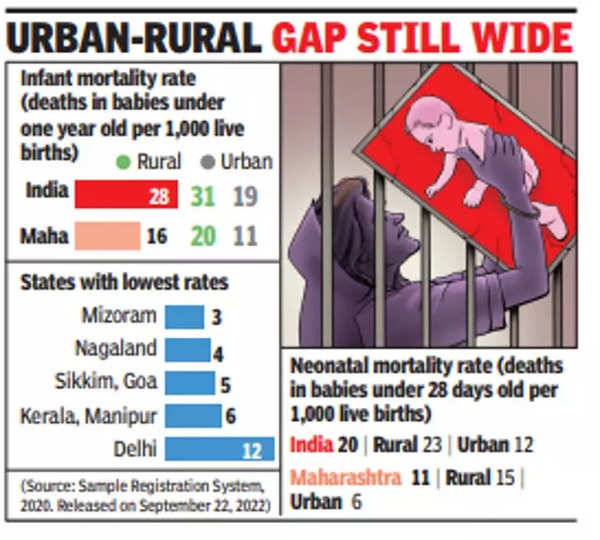Top Searches
- News
- City News
- mumbai News
- Maharashtra meets UN targets on child mortality reduction
Maharashtra meets UN targets on child mortality reduction

There is a difference of nine points, though, in the NMR numbers between Maharashtra's urban and rural areas. (Representative image)
MUMBAI: Maharashtra continued to see a steady decline in the neonatal, infant and under-five mortality rates and has fared among six to 11 states that have achieved targets set under the UN's sustainable development goals (SDGs) to bring down child deaths, as per the Sample Registration System (SRS), 2020, data released on Thursday. An urban-rural divide, though, is seen in the figures.
The neonatal mortality rate (NMR) was 11, putting the state among six others in the country to achieve the SDG target of fewer than 12 deaths per 1,000 live births.

Maharashtra's infant mortality rate (IMR) is 16 now against the India average of 28, and the under-five mortality rate is 18 now compared to the national average of 32. The SDG target for under-five was to reduce deaths to fewer than 25 per 1,000 live births. It has put Maharashtra in the league of 11 states to reach the milestone, including Kerala (8), TN (14) and Delhi (14).
There is a difference of nine points, though, in the NMR numbers between Maharashtra's urban and rural areas. While urban Maharashtra (6) has met the SDG goal for reduction in neonatal mortality, rural Maharashtra (15) has quite a distance to travel. For IMR, the urban figure was 11 and rural, 20. The best states, like Mizoram, Kerala, Manipur and Sikkim, reduced nearly all mortality rates to under 10.
Paediatrician Abhay Bang, who has been working in tribal Gadchiroli, called for data on micro trends to get an accurate picture. "Hidden within these relatively lower mortality rates are both the Marine Drives and the Melghats," he said on Friday. The SRS does not provide district-wise rates. "Most unfortunately, the SRS does not provide a separate estimate of the IMR in tribal population, which is more than a crore in Maharashtra," Dr Bang said. An expert committee on tribal health gave the government this suggestion in 2018, but to little effect.
Vivek Pandit of Shramajivi Sangathana said such low rates are hard to accept when malnutrition exists in many districts, such as Palghar, Raigad, Thane and Nashik. "There is no doubt that deaths have come down, but the state still records thousands of them annually," he said, adding that deaths are missed too. In the past decade, IMR has dropped by 43% in Maharashtra.
There is a need to comprehend the shift in causes of death and strategise accordingly, said Dr Jayashree Mondkar, professor emeritus of neonatology at Sion hospital. "Earlier infectious diseases were big killers, but now we see maximum deaths due to congenital problems, prematurity," she said.
The neonatal mortality rate (NMR) was 11, putting the state among six others in the country to achieve the SDG target of fewer than 12 deaths per 1,000 live births.

Maharashtra's infant mortality rate (IMR) is 16 now against the India average of 28, and the under-five mortality rate is 18 now compared to the national average of 32. The SDG target for under-five was to reduce deaths to fewer than 25 per 1,000 live births. It has put Maharashtra in the league of 11 states to reach the milestone, including Kerala (8), TN (14) and Delhi (14).
There is a difference of nine points, though, in the NMR numbers between Maharashtra's urban and rural areas. While urban Maharashtra (6) has met the SDG goal for reduction in neonatal mortality, rural Maharashtra (15) has quite a distance to travel. For IMR, the urban figure was 11 and rural, 20. The best states, like Mizoram, Kerala, Manipur and Sikkim, reduced nearly all mortality rates to under 10.
Paediatrician Abhay Bang, who has been working in tribal Gadchiroli, called for data on micro trends to get an accurate picture. "Hidden within these relatively lower mortality rates are both the Marine Drives and the Melghats," he said on Friday. The SRS does not provide district-wise rates. "Most unfortunately, the SRS does not provide a separate estimate of the IMR in tribal population, which is more than a crore in Maharashtra," Dr Bang said. An expert committee on tribal health gave the government this suggestion in 2018, but to little effect.
Vivek Pandit of Shramajivi Sangathana said such low rates are hard to accept when malnutrition exists in many districts, such as Palghar, Raigad, Thane and Nashik. "There is no doubt that deaths have come down, but the state still records thousands of them annually," he said, adding that deaths are missed too. In the past decade, IMR has dropped by 43% in Maharashtra.
There is a need to comprehend the shift in causes of death and strategise accordingly, said Dr Jayashree Mondkar, professor emeritus of neonatology at Sion hospital. "Earlier infectious diseases were big killers, but now we see maximum deaths due to congenital problems, prematurity," she said.
FOLLOW US ON SOCIAL MEDIA
FacebookTwitterInstagramKOO APPYOUTUBE
Start a Conversation
end of article









